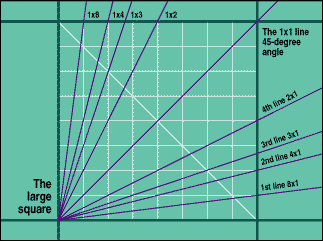Q&A
Since You Asked
| Here's something that's been too long in the planning: a question & answer column. Professional trader Don Bright of Bright Trading, an equity trading corporation, answers a few of your questions. | 
Don Bright of Bright Trading |
HOW TO CREATE A GANN FAN LINE
Can anybody help me in explaining how to chart a Gann fan line? -- Altaf Merchant
Here is the basic definition of a Gann fan. Gann angles are drawn between a significant bottom and top (or vice versa) at various angles. Deemed the most important by creator W.D. Gann, the 1x1 trendline signifies a bull market if prices are above the trendline or a bear market if below. Gann felt that a 1x1 trendline provides major support during an uptrend and when the trendline is broken, it signifies a major reversal in the trend. Gann identified nine significant angles, with the 1x1 being the most important:
| Angle Degree 1x8 82.50 1x4 75.00 1x3 71.25 1x2 63.75 1x1 45.00 2x1 26.25 3x1 18.75 4x1 15.00 8x1 07.50 |

FIGURE 1: SQUARE. Gann derived nearly all his angles by drawing them on an 8x8 square, using the intersections of the internal boxes and the external box; 3x1 and 1x3 are derived differently. |
If you use the measurements given over a period of time, you will see the "fan" (Figure 1). Gann angles are, of course, designed for identifying trends in overall markets. You use the Standard & Poor's 500, for example, to identify bear and bull markets.
COMMODITY OPTIONS
I have an interview for a commodity options trader position and I know nothing about the commodities market! Do commodity options work the same way as equity options? Are there only futures contracts in the commodities market? Any information you have would be greatly appreciated. Thanks! -- Niki Gibbs
There are futures contracts on commodities ranging from "feeder cattle" to "cheddar cheese" (and everything in between). Most of these also have options contracts on them. The options allow for more leverage and can be traded by following the futures themselves. The disparity that occurs between options and futures can be "arbed" (arbitraged) for profits. They are similar to equity options in that both have strike prices and series (expiration month). I suggest you go to the Chicago Mercantile Exchange (CME) Website at https://www.cme.com and enroll in one of the online trading classes you'll find there. This way, you may be able to learn the basics prior to venturing into this new endeavor.
SMITH INDICATOR MARKET TIMING
Any comments on the "Smith indicator"? It seems good at indicating overbought and oversold conditions. -- No Name Given
For those who don't know, the "Smith indicator" is a market timer dedicated to going in and out of Fidelity Funds in your 401(k). It uses a combination of neural network and pattern recognition technology. Talk about a specialized focus!
Since I prefer relying on my own market timing, I would simply use it as only one of many indicators. You must always keep your costs in mind when going in and out of any investment.
STOCK SPLITS HIGHER OR LOWER?
I am new to the market and was researching stock splits. I wonder if it is better to have more shares with a lower value or fewer shares with a higher value. Or does it matter? -- No Name Given
The math and dollar values work out the same in stock splits. If you have 100 shares at $50 or 200 shares at $25, the value is the same. However, you should be aware of why companies split their shares in the first place. When a stock is trading at $200 or more, then the cost to buy a "round lot" (100 shares) is $20,000, which is somewhat high for the average investor. So when the stock splits to a price of $50 or thereabouts, more people can easily purchase the shares. This can cause some initial upward movement in the stock price, at least short term. Many traders play the split with an upward bias. This is a strategy to be used by professionals only . . . do not try this at home!
Don Bright is a principal with Bright Trading (www.stocktrading.com), a professional equity trading corporation with offices around the United States. E-mail your questions for Bright to Editor@traders.com, with the subject line directed to "Don Bright Question."
Excerpted from an article originally published in the November 2000 issue of Technical Analysis of STOCKS & COMMODITIES magazine. All rights reserved. © Copyright 2000, Technical Analysis, Inc.
Return to November 2000 Contents